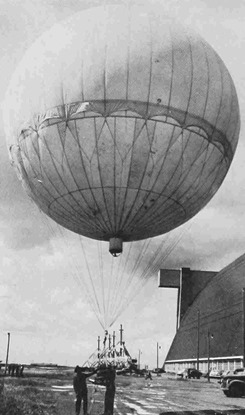23 items in this album on 2 pages.
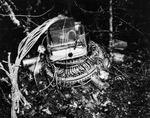 | 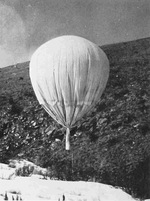 |  | 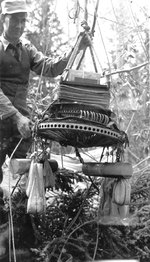 |
| The chandelier style gondola of a Japanese Fu-Go balloon bomb recovered in the Klamath Mountains between Red Bluff and Hayfork, California, United States 1 Feb 1945. Note the clear battery box on top. | Nearly deflated Japanese Fu-Go Type A balloon grounded near Tremonton, Utah, United States, 23 Feb 1945. The ballast dropping equipment found with this balloon was damaged. | A Royal Canadian Navy intelligence officer approaching a downed Japanese Fu-Go balloon bomb in the western Canadian provinces, circa Mar 1945. Note the incendiary bombs still attached. | Captain Harold Cross of the Canadian Army was a balloon expert and is seen here next to a Japanese Fu-Go balloon’s ballast dropping apparatus after a balloon bomb recovery in Canada. |
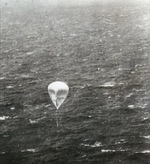 | 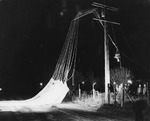 | 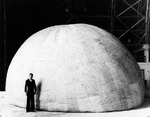 | 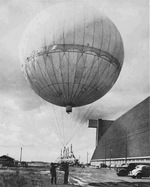 |
| United States Army photo of a partially deflated Japanese Fu-Go balloon bomb over the Pacific Ocean, likely near the Aleutian Islands. This shows why these descending balloons were often mistaken for parachutes. | Japanese Fu-Go balloon bomb draped across power lines in Toppenish, Washington, United States, 10 Mar 1945. This balloon caused a power outage that briefly affected the Hanford nuclear reactors 40 miles away. | A captured and partially reinflated Japanese Fu-Go Type A balloon bomb inside the blimp hangar at Naval Air Station Moffett Field, Mountain View, California, United States, Aug 1945. | A captured and reinflated Japanese Fu-Go paper Type A balloon being evaluated at Naval Air Station Moffett Field, Mountain View, California, United States, Aug 1945. |
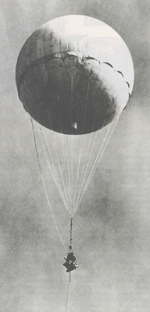 | 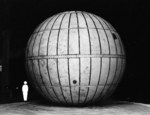 | 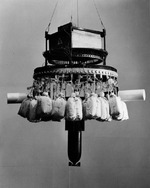 | 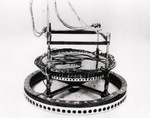 |
| A captured and reinflated Japanese Fu-Go Type A balloon bomb on a tethered test flight at Naval Air Station Moffett Field, Mountain View, California, United States, Aug 1945. | A captured and reinflated Japanese Type B Fu-Go rubberized silk balloon, Aug 1945. Probably inside the blimp hangar at Naval Air Station Moffett Field, Mountain View, California, United States. | A recovered ballast dropping apparatus from a Japanese Fu-Go balloon bomb that has been reassembled for demonstration purposes. | A stripped-down view of the chandelier style frame of the ballast dropping apparatus from a captured Japanese Fu-Go balloon bomb. |
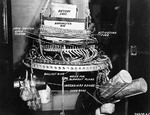 | 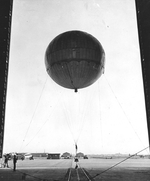 | 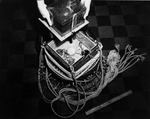 | 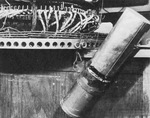 |
| Annotated photo of the payload components of a Japanese Fu-Go balloon bomb, circa Aug 1945. | A captured Japanese paper Fu-Go Type A balloon bomb, reinflated for testing, being wheeled out of the blimp hangar at Naval Air Station Moffett Field, Mountain View, California, United States, 27 Aug 1945. | A recovered ballast dropping apparatus from a Japanese Fu-Go balloon bomb being examined by an American technician. He is removing the battery case to expose the components of the barometer box beneath. | Close up of a Japanese 5kg Type A incendiary bomb hanging from a ballast ring of a Fu-Go balloon bomb, mid-1945. Note the two blowout plugs in the ballast ring supporting this bomb. |
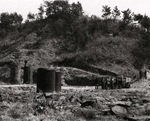 | 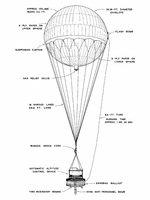 | 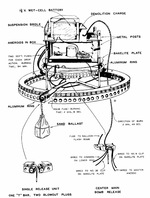 |  |
| Men of the United States Army 1st Cavalry Division examining the freshly discovered launch site for the Fu-Go balloon bombs at Otsu, Japan Apr 1947. The dark barrel-shaped devices are gas generators for the hydrogen gas. | Annotated diagram of a Japanese Fu-Go Type A balloon bomb from top to bottom. | Annotated diagram of a Japanese Fu-Go Type A balloon bomb from top to bottom. | Postwar American chart roughly showing the path of the jet-stream used by the Japanese Fu-Go balloon bombs. The actual path curved sharply northward along the Aleutians and down the North American coast. |
23 items in this album on 2 pages.




















